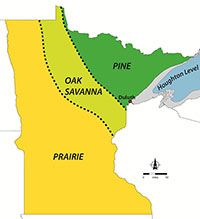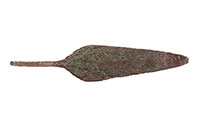When the Big Lake Wasn’t So Big: The Archaic Period
(c. 7500 – c. 500 B.C.)
About 9,000 years ago, the region that is now Minnesota continued to experience dramatic environmental changes. Warmer temperatures and decreased precipitation resulted in much of the state being covered by an expanse of prairie interspersed with large lakes and swiftly-flowing rivers fed by glacial runoff. During this period, the northeast portion of the state, including most of St. Louis County and all of Lake and Cook counties, remained covered in pine forest, although the Duluth area bordered on a region of oak savanna. These environmental changes contributed to the extinction of the large mammals of the Ice Age and their replacement by our current group of animals including white-tailed deer, moose, and bear among others. About 4900 B.C., the climate shifted once again to one that was cooler and wetter. This transition led to the establishment, by about 1200 B.C., of the state’s present mix of prairie and forest biomes.
In response to this transforming landscape and the variety of game, fish, and plant resources now present, changes also took place in the lives of the region’s inhabitants. Referred to as the Archaic period, this era is marked by an increase in the diversity of tool types, raw materials, and local resources being utilized. The large lanceolate projectile points of the Paleoindian tradition were replaced by smaller notched and stemmed stone points for hunting game, while the use of groundstone tools for processing plant material increased. Other implements introduced in the Archaic period included tools made of bone and native copper. Objects made of copper are primarily found in the northern regions of the state. Because of an increased ability to depend on regional resources within an increasingly stable environment, Archaic people became less nomadic and established longer-term seasonal camps with temporary structures and associated storage pits.
In general, the Archaic period is poorly represented in the Duluth area and along the Lake Superior shore. Water levels within the Lake Superior basin were much lower during this era reaching an all-time low (referred to as the Houghton Level) about 6,500 B.C. At the water’s lowest levels, the tip of the lake had receded into the Lake Superior basin as far north and east as present-day Silver Bay, Minnesota. Due to these fluctuating water levels, campsites located along the Superior lakeshore during the Archaic period would now be underwater. Archaic period archaeological sites are more prevalent inland where they have been documented in the Reservoir Lakes area and within Superior National Forest.
Associated Images
click for larger image with caption
Copyright © 2022. All rights reserved.




